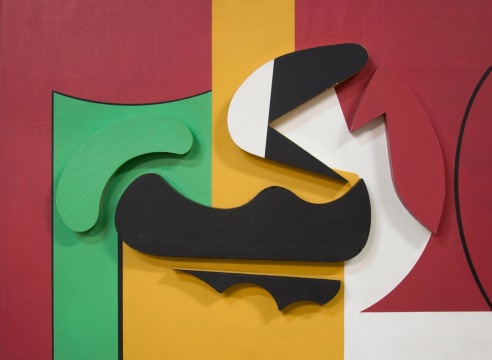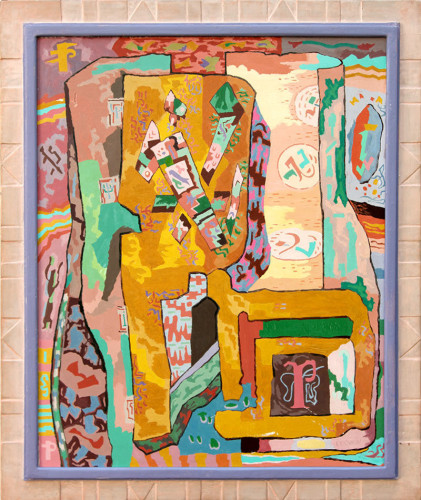
group

K-3, 1951
30 x 24 inches | oil on board
Peter Krasnow was an American artist born in the Ukraine, Russia to a Jewish family in August of 1886. As a boy he was an apprentice to his father, an interior decorator, and worked learning how to grind and blend colors. The impact of these formative years is what sparked Krasnow’s interest in art and is evidenced by the attention to color and design, in his work. The Ukraine offered no training in the field of art, so Peter Krasnow came to the United States in 1907 to Boston, later moving to Chicago where he attended the Art Institute. In Chicago he worked as a security officer and jobs of manual labor to put himself through school. It was there that he met his future wife Rose Bloom (1885-1984), a writer of poetry, short stories, and plays. Krasnow graduated from the Art Institute in 1916 and after marrying Rose they went to New York City “...inspired by vivid descriptions and promises of better opportunities” (Krasnow interview, 1975).
The Krasnows, living in a tenement, quickly tired of the busy, sordid city. Krasnow felt the lack of nature in the urban environment and rented a studio outside the city and used the surrounding landscape as the subject for his paintings. His first exhibit of these landscapes at the Whitney Studio in New York attracted the attention of critics, one in particular who asked Krasnow if he had ever been to California. This casual question led to the eventual departure of Peter and Rose from the East coast to become West coast residents for the rest of their lives, excepting a 3 year sojourn to the Dordogne region of France.
The Krasnows arrived in California in 1922 and in 1923 Peter built his own studio on land purchased from Edward Weston, the acclaimed photographer, who became a lifelong friend. A small group of artists in the 1920’s were trying to establish a community of California avant garde artists, Krasnow among them. Other artists in Krasnow’s circle included Weston, painters S. MacDonald Wright, Nick Brigante, Boris Deutsch, Henrietta Shore, and Lorser Feitelson. Peter Krasnow received a $7,500 fellowship from the National Endowment for the Arts in 1977 toward the end of his career. Krasnow’s self-built studio in Glendale was the main residence of Peter and Rose for the rest of their lives. Peter Krasnow died in Los Angeles on October 30, 1979.
ANALYSIS OF THE ARTIST'S WORK
Peter Krasnow had very definite ideas about what his work meant both to himself and the viewer. In an interview from January of 1975 Krasnow defines his work:
“Meaning in a painting is derived from quality. It is reciprocal and will return what has been given to it both to its creator and to the beholder, by a multiple combination in visual concept of pattern, color, form, and that undefined intangible which transcends all classifications. My paintings subscribe o no period or school. If they possess that sustaining power of meaning and authenticity which constitute the basic attributes of a work of art, as well as an awareness of the contemporary scene, they will be illustrative of the progressive trends of their time. Their visible concept may ostensibly reveal characteristics of Time and Place, but the roots reach deep into ethnic strains of ancient culture through which the archetype emerges as indicator of the universal and eternal urge toward creation.”
Peter Krasnow’s early works are most often city scenes and the palette he used was rich and dark. These paintings echo the Ashcan artists with their urban subject matter. A street scene of a market in New York City (1919) could be mistaken for a market day in Russia. The women bundled and wrapped against the cold and the dark, brooding palette are suggestive of Krasnow’s formative years in the Ukraine. These early works incorporated contemporary surroundings of buildings and people, many of mothers with their children.
After moving to California in the early 1920s, Krasnow’s palette lightens up. He created a number of landscape watercolors and other paintings that garnered him a successful exhibition at the Palace of the Legion of Honor in San Francisco. The success of that exhibition could have been a major catalyst for Krasnow’s career, but he chose instead to experience France, the art capital of the world, to further develop his work. After a short time in Paris he and Rose removed to the countryside of the Dordogne region of France and produced a series of watercolors and paintings of a landscape that “...just cried out to be painted” (Krasnow, 1975). He was given a rent-free space in which to paint. The citizens of the small town entreated the Krasnow’s to stay and become a permanent part of their community, but Krasnow knew he would need to return to California. The compromise with the townspeople was that he exhibit the works produced in their town before his return to the United States, which he did in Paris at the Galerie Pierre in 1934.
Back in Los Angles, Krasnow spent approximately the next ten years producing wood sculptures he named “demountables”. His experience of wood sculpture in European museums was that the medium was difficult to distinguish from any other medium; the wood was not celebrated as an organic and generic product, but made to look like bronze or marble. Krasnow’s “demountables” are totemic figures of interconnecting geometric shapes. The intricacy of their configuration and the combinations of different grains and colors invite the viewer participation in understanding their interlocking patterns. They range in size from 24” to 119” high by 8” to 103” wide. These sculptures celebrated the knots and whorls within the wood, and ultimately the trees themselves, some of which came from Krasnow’s own property.
In 1944 the war was in full swing and Krasnow turned back to painting. Within the dark days of war Krasnow’s goal was produce paintings of light. The paintings produced in the 1940s until his death in 1979 were colorful, geometric designs often incorporating abstract images taken from his Jewish heritage. The paintings are symmetrical with multicolored bands and rectangles creating order and light in a chaotic world. Krasnow’s paintings show a desire for structure and symmetry and have been compared to paintings by Piet Mondrian.
AWARDS & AFFILIATIONS
1977 National Endowment for the Arts, fellowship
COLLECTIONS
Phoenix Art Museum, Phoenix, AZ
University of Arizona Art Museum, Tucson, AZ
DeSaisset Museum, Santa Clara, CA
Galka E. Scheyer Collection – Norton Simon Museum, Pasadena, CA
Judah L. Magnes Museum, Berkeley, CA
Laguna Art Museum, Laguna Beach CA
Long Beach Museum of Art, CA
Los Angeles County Museum of Art, Los Angeles, CA
Monterey Peninsula Museum of Art, Monterey CA
Oakland Art Museum, Oakland, CA
Palm Springs Desert Museum of Art, Palm Springs, CA
Pasadena Art Museum, Pasadena, CA
Skirball Museum, Hebrew Union College, Los Angeles, CA
San Jose Museum of Art, San Jose, CA
San Francisco Museum of Modern Art, San Francisco, CA
Santa Barbara Museum of Art, Santa Barbara, CA
University Art Museum, Berkeley, CA
Spertus Museum, Chicago, IL
Herzliya Museum of Art, Israel
Sheldon Memorial Art Galleries, University of Nebraska
The Jewish Museum, New York, NY
Carnegie Institute, Museum of Art, Pittsburgh, PA
Marion Koogler McNay Art Museum, San Antonio, TX
Nora Eccles Harrison Museum of Art, Logan UT
National Museum of American Art, Washington, D.C.
University of Judaism, Los Angeles, CA
BIBLIOGRAPHY
1. Karlstrom, Paul J. Archives of American Art Journal, 1997 (Volume 37 Numbers 3 and 4) P. 48. Smithsonian Institution,Washington, DC.
2. WIlson, William. Krasnow, 92: Anonymity from Fame. Los Angeles Times, November 4, 1979, Calendar, P. 5.
3. Los Angeles Municipal Art Gallery, Peter Krasnow; A Retrospective Exhibition. February 26-March 23, 1975
4. Tobey Moss Gallery, Los Angeles, CA. Exhibition catalogs 1986, 1989, 1991, 1993 and 1996.
5. Moss, Tobey. Peter Krasnow. ArtScene, September 1991 (Vol. 11, No. 1) p. 21-22.
6. Journal from t he Los Angeles Institute of Contemporary Art, December 1976 (no. 3).
7. Los Angeles Times Art Review, November 6, 1978.
8. Hughes, Edan Milton. Artists in California, p. 644. San Fran: Hughes Pub., 1989.
9. Peter Krasnow, AskArt.com.
10. Mclelland, Gordon. California Watercolors; An Illustrated History and Biographical Dictionary. p. 144.
EXHIBITIONS
1986, 1989, 1991, 1993 Tobey C. Moss Gallery, Los Angeles, CA
1978 Skirball Museum, Hebrew Union College, Los Angeles, CA
1977 Judah L. Magnes Museum, Berkeley, CA
1976 San Francisco Museum of Art, San Francisco, CA
1975 Los Angeles Municipal Art Gallery, Barnsdall Park, CA
1964 Scripps College, Claremont, CA (solos)
1954 Pasadena Art Institute, Pasadena, CA
1940 UCLA, Los Angeles, CA
1940 Stendahl Galleries, Los Angeles, CA (solo)
1939 Fine Arts Gallery, San Diego, CA
1935 California Pacific International Expo, San Diego, CA
1935 The Print Rooms, Los Angeles, CA
1935 UCLA, Los Angeles, CA
1934 Galerie Pierre, Paris, France (solo)
1931 California Palace of Legion of Honor, San Francisco, CA (solo)
1930 Stendahl Galleries, Los Angeles, CA (solo)
1929 Scripps College, Claremont, CA (solo)
1928 Zeitlin Bookstore, Los Angeles, CA (solo)
1928 Dalzell Hatfield Gallery, Los Angeles, CA (solo)
1928 Seattle Society of Fine Arts, Seattle WA (solo)
1928 Oakland Municipal Art Gallery, Oakland, CA (solo)
1927 Temple Emanu-el, San Francisco, CA
1926,1935 The Print Rooms, Los Angeles, CA
1923 MacDowell Club, Los Angeles, CA (solo)
1922, 1927 Los Angeles County Museum of Art, Los Angeles, CA
1922 Whitney Studio Club, New York, NY (solo)